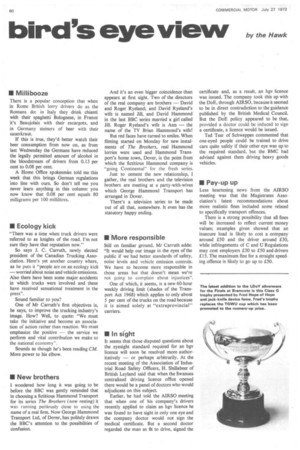bird's eye view by the Hawk
Page 62

If you've noticed an error in this article please click here to report it so we can fix it.
• Millibooze
There is a popular conception that when in Rome British lorry drivers do as the Romans do: in Italy they drink chianti with their spaghetti Bolognese, in France it's Beaujolais with their escargots, and in Germany steiners of beer with their sauerkraut.
If this is true, they'd better watch their beer consumption from now on, as from last Wednesday the Germans have reduced the legally permitted amount of alcohol in the bloodstream of drivers from 0.13 per cent to 0.08 per cent. A Home Office spokesmim told me this week that this brings German regulations into line with ours. So don't tell me you never learn anything in this column: you now know that 0.08 per cent equals 80 milligrams per 100 millilitres.
• Ecology kick
"There was a time when truck drivers were referred to as knights of the road. I'm not sure they have that reputation now."
So says J. C. Carruth, newly elected president of the Canadian Trucking Association. Here's yet another country where, as he puts it "people are on an ecology kick — worried about noise and vehicle emissions. Also there have been some major accidents in which trucks were involved and these have received sensational treatment in the press".
Sound familiar to you?
One of Mr Carruth's first objectives is, he says, to improve the trucking industry's image. How? Well, to quote: "We must take the initiative and become an association of action rather than reaction. We must emphasize the positive the service we perform and vital contribution we make to the national economy".
Sounds as though he's been reading CM. More power to his elbow.
• New brothers
I wondered how long it was going to be before the BBC was gently reminded that in choosing a fictitious Hammond Transport for its series The Brothers (now resting) it was running perilously close to using the name of a real firm. Now George Hammond Transport Ltd, of Dover, has politely drawn the BBC's attention to the possibilities of confusion.
And it's an even bigger coincidence than appears at first sight. Two of the directors of the real company are brothers David and Roger Ryeland; and David Ryeland's wife is named Jill, and David Hammond in the last BBC series married a girl called Jill. Roger Ryeland's wife is Ann — the name of the TV Brian Hammond's wife!
But red faces have turned to smiles. When filming started on Monday for new instalments of The Brothers, real Hammond lorries were used and Hammond Transport's home town, Dover, is the point from which the fictitious Hammond company is -going Continental" for the fresh series.
Just to cement the new relationship, I gather, the real brothers and the television brothers are meeting at a party-with-wives which George Hammond Transport has arranged in Dover.
There's a television series to be made out of all that, somewhere. It even has the statutory happy ending.
• More responsible
Still on familiar ground, Mr Carruth adds: "It would help our image in the eyes of the public if we had better standards of safety, noise levels and vehicle emission controls. We have to become more responsible in those areas but that doesn't mean we're not going to complain about injustices".
One of which, it seems, is a new 60-hour weekly driving limit (shades of the Transport Act 1968) which applies to only about 5 per cent of the trucks on the road because it is aimed solely at "extraprovincial" carriers.
• In sight
It seems that those disputed questions about the eyesight standard required for an hgv licence will soon be resolved more authoritatively — or perhaps arbitrarily. At the recent meeting of the Association of Industrial Road Safety Officers, H. Shillabeer of British Leyland said that when the Swansea centralized driving licence office opened there would be a panel of doctors who would adjudicate on this subject.
Earlier, he had told the AIRSO meeting that when one of his company's drivers recently applied to claim an hgv licence he was found to have sight in only one eye and the company doctor would not sign the medical certificate. But a second doctor regarded the man as fit to drive, signed the certificate and, as a result, an hgv licence was issued. The company took this up with the DoE, through AIRSO, because it seemed to be in direct contradiction to the guidance published by the British Medical Council. But the DoE policy appeared to be that, provided a doctor could be induced to sign a certificate, a licence would be issued.
Ted Teer of Schweppes commented that one-eyed people could be trained to drive cars quite safely if their other eye was up to the required standard, but the BMC had advised against them driving heavy goods vehicles.
• Pay-up up
Less heartening news from the AIRSO meeting was that the Magistrates Association's latest recommendations about more realistic fines included some related to specifically transport offences.
There is a strong possibility that all fines will be increased to reflect current money values; examples given showed that an insecure load is likely to cost a company around £50 and the driver around £30, while infringements of C and U Regulations may cost employers £30 to £50 and drivers £15. The maximum fine for a straight speeding offence is likely to go up to £50.
























































































































































